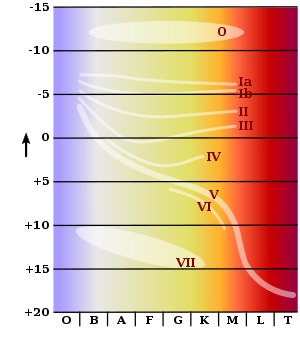Yellow dwarf
A yellow dwarf or main sequence star of spectral class G is a star of spectral class G and luminosity class V. An example of a yellow dwarf is the sun . The yellow dwarfs are located roughly in the middle of the Hertzsprung-Russell diagram . The name yellow dwarf is derived from the relatively small size of these stars (compared to red giants, for example ) and their yellowish color .
properties
Yellow dwarfs with masses of 0.8 to 1.1 solar masses have surface temperatures of around 5300 K to 6000 K. Most of the yellow dwarf stars belong to the star population I. Every second the sun fuses around 600 million tons of hydrogen to form helium , converting around 4 million tons of matter into energy .
Standard spectral stars
The revised Yerkes Atlas (Johnson & Morgan 1953) lists 11 yellow dwarf stars as the standard, with some removed from the list over time. The anchors of the MK system form the following stars:
- Asterion (G0V)
- the sun (G2V)
- Kappa1 Ceti (G5V)
- 61 Ursae Majoris (G8V)
Others add HD 115043 (G1V) and 16 Cygni B (G3V) to this list . The choice of G4V, G6V, G7V, and G9V standard stars is less clear-cut.
development
A yellow dwarf stays in the main sequence for about 10 billion years during its existence . It is assumed that all yellow dwarfs develop into a red giant in the further course of their existence , whereby a supernova does not occur. Eventually the red giant collapses into a white dwarf .
Examples
| Surname | Mass in M ☉ | Radius in R ☉ | Luminosity in L ☉ |
|---|---|---|---|
| 55 Cancri A. | 0.95 | 0.96 | 0.63 |
| Alpha Centauri A | 1.11 | 1.22 | 1.52 |
| Alpha Mensae | 0.87 | 0.85 | 0.82 |
| 51 pegasi | 1.06 | 1.15 | 1.34 |
| 18 Scorpii | 1.01 | 1.03 | 1.08 |
| Sun | 1.00 | 1.00 | 1.00 |
| Tau Ceti | 0.77 | 0.82 | 0.52 |
Web links
Individual evidence
- ↑ Why Does The Sun Shine? , lecture, Barbara Ryden, Astronomy 162, Ohio State University , accessed on line June 19, 2007.
- ↑ Sun ( Memento of the original from June 16, 2007 in the Internet Archive ) Info: The archive link was inserted automatically and has not yet been checked. Please check the original and archive link according to the instructions and then remove this notice. , entry at ARICNS, accessed June 19, 2007.
- ↑ HL Johnson & WW Morgan: Fundamental stellar photometry for standards of spectral type on the revised system of the Yerkes spectral atlas , 1953, Astrophysical Journal, 117, 313, bibcode : 1953ApJ ... 117..313J .
- ↑ MK ANCHOR POINTS , Robert F. Garrison
- ↑ PC Keenan & RC McNeil: The Perkins Catalog of Revised MK Types for the Cooler Stars . In: Astrophysical Journal Supplement Series , 71 (October 1989), pp. 245-266. bibcode : 1989ApJS ... 71..245K

